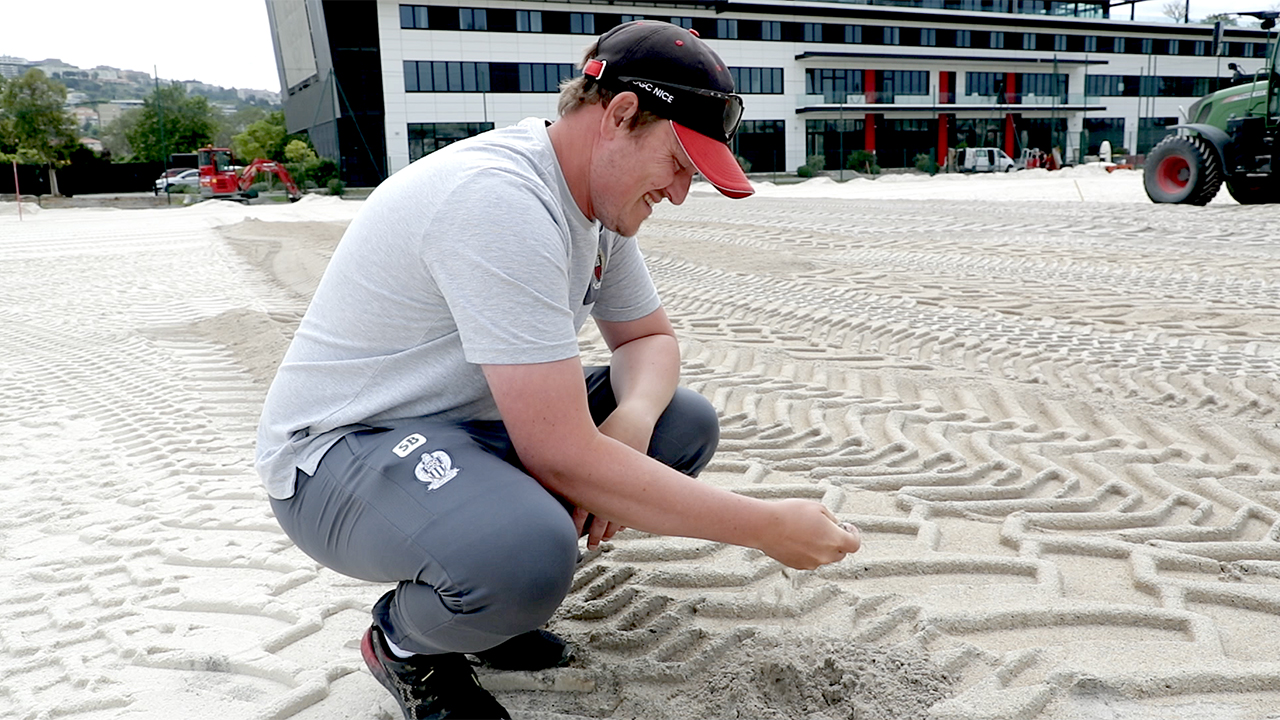
Focus
Scott Brooks, the grounds manager
Meticulous, dedicated and determined, Scott Brooks has been working hard since his arrival in January to ensure Les Aiglons can train on perfect pitches day in, day out. Having worked at Arsenal, Tottenham and Saint George's Park - the national centre of the English Football Association - and as an expert in his field, the OGC Nice grounds manager, speaks about his major projects, his method and his objectives.
No sooner had you arrived, than you rolled up your sleeves and got to work…
I didn't want to spend six months or a year like just feeling my way around and not really achieving much. So I wanted to come in and hit the ground running. So I concentrated it on one pitch in particular that I knew we could achieve a good level and try to improve it on a daily basis.
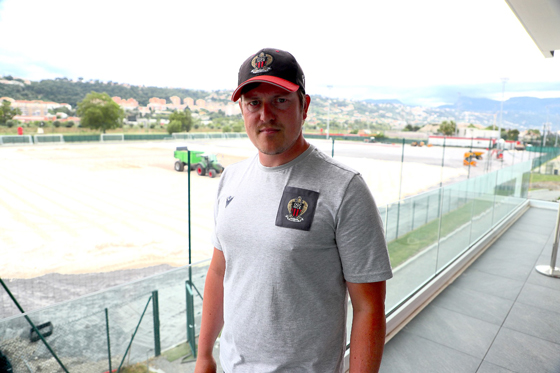
Is mutual confidence important?
Of course. Developing a bond of trust with the players, the coaches and obviously the club management is important. When the time comes to invest in the new pitches, they would have confidence in what I'm doing and believe in my philosophy. We're very lucky that the climate here is quite good for growing grass from February so we were able to make some big improvements very quickly.
What were your other priorities?
When I arrived, I did a full assessment of all the pitches, and I was only really happy with one of them. So the two pitches next to this one couldn't meet the performance level that I felt was required for a professional athlete.
What constitutes a good football pitch?
When I talk about performance level, I mean in terms of the pitch protecting the player from injury, and then to reach their maximum level. We even did a little renovation on one of the pitches to see whether we could grow a good pitch and we weren't at the level that I feel is important for the athlete so we took the decision to reconstruct.
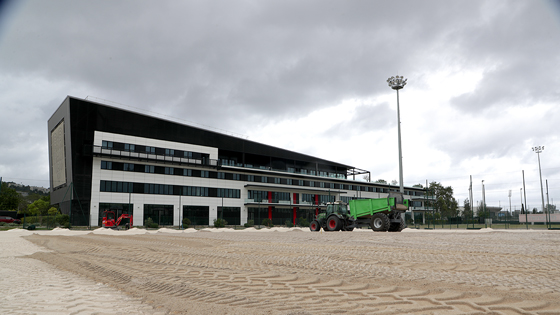
THE SOUTH OF FRANCE IS ONE OF HARDEST CLIMATES IN EUROPE FOR GROWING A PITCH
What were the problems with the pitches when you arrived?
Every day the player goes out and works on the pitch, damages the pitch, the grass. If the plant is strong and healthy, it will recover quickly. If the plant is already stressed and someone like tramples it with a football boot, it's not going to come back very quickly and the pitch will deteriorate quickly. The new constructions have this stability in the support structure, so even if the grass isn't perfect, the pitches still play very well.
What role does the weather play?
I actually think the south of France in terms of Europe is one of the most difficult climates for growing grass. We never really have perfect weather for a prolonged period. The pitches might be very, very good in April or May, or again in October, but they're not perfect every month for the season. My biggest challenge is creating a pitch that's good for every month of the season.
Can the quality of a pitch like this have an influence on players getting injured?
The pitch is probably more than half of the reason why a player would get injured. If the playing surface doesn't help them in their daily work, then the risk of injury is very high. Thanks to the new construction of the pitches, the playing surface can adapt to the needs of the coaching staff. . I can prepare the pitch to help the players hit their maximum during the session, whether it be a high-intensity session of 45 minutes or a two-hour session. At the end of the day, the players need to come off the pitch tired after giving it everything, but without any pain. Also the injury rates on of the players here was very high and I believe this was down to the old construction of the pitch. So we should see less injuries and fitter, healthier players. That’s my aim: do everything so no one can say anything against the pitches.
What influence can the pitch have on the team’s performance?
It can raise a players’ intensity level because he can work at his maximum without injuring his back or knees. He can always trying really hard and as a result, like his level will go up. He can reach his full potential and that in turn can transform a potential defeat into a draw, or a draw into a win. My role is to help the team at my level and give the coach the tools he needs to apply and put into practice his philosophy. Expectations are high.
Have you changed more than just the grass?
Of course. You can’t just rebuild the pitch. Take the irrigation for example. We have installed a new irrigation system with holding tanks for storing water. So if there's a problem getting the water from the mains, we'll have enough water stored on site to keep the pitches alive. On top of that, we have also increased the pressure so that the water goes where it's supposed to go and we use less water. In the long term, I hope this will help to save around 30 percent water usage.
How?
I chose a system used for watering watermelon in Brazil where the climate is generally quite dry like here in Nice. I have adapted it to football. It'll be the first of its kind and the idea is that when you water the pitch, the water goes through the profile better, through the construction of the pitch.
.jpg)
Above and beyond the performance of the pitch, you are also very conscious about the environment…
It's our responsibility to be thinking about sustainability and the environment and looking after the world. We're not using fossil fuels to cut the grass with electric lawnmowers and the water is another step in the right direction.
Why is a stable pitch so important?
If the players run and the pitch moves too much, then that's where they start to get problems with muscle fatigue and things like that. Sometimes you use one sand all the way through and mix it with a little bit of organic in the top for the nutrient retention. But here we felt it was necessary to use the two different sands. The pure sand pitch requires careful watering. Not necessarily more water, just water that covers the whole surface evenly. The new irrigation system allows us to do that. Now I can put the sprinklers on just five minutes and everything will be perfect for training.
What other companies are helping you here?
I didn't want to just bring England to Nice and not embrace what the French companies had to offer. I worked previously with the French company ‘Natural Grass’ at Arsenal and I knew they were a very professional company. So when we decided to build the pitches here, they were they were my first choice.
I’M ALWAYS LISTENING TO THE COACH AND THE PLAYERS
What is your relationship with the players?
I'm always looking for feedback off the players. For example, the players quite often complained about the pitch we were talking about earlier, that it felt a little bit dead and they'd come off feeling very tired, especially in the lower back. During his rehabilitation, Yucef Atal worked on it for an hour and he come off the pitch and the first thing he said was that he didn’t feel anything. For me that was the most positive thing I've heard since I've been here.
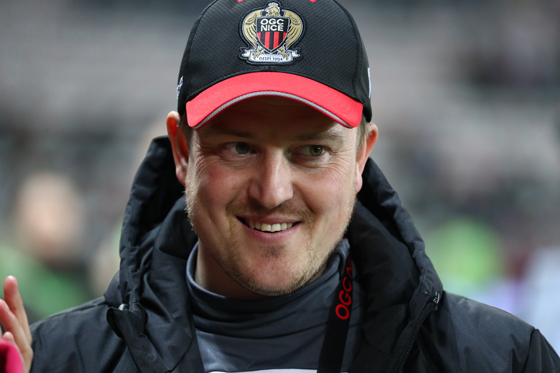
Are you also working with the artificial pitches?
The synthetic pitches are a great asset for OGC Nice, where they have lots of teams that need to use a pitch for lots of hours. People think you just install and then you never have to touch it again. But, you know, a good synthetic pitch maintained properly can again help the players to achieve a very high level. And the thing I like about synthetic pitches is because of the construction of it, the makeup of it, it makes the player use different muscle groups compared to if they train on natural grass. So if you're training on both synthetic pitches and natural pitches, you can actually create athletes that are a little bit stronger and a little bit more robust when it comes to injuries.
How will the pitches be set up and used during the 2020-21 season?
Of the three first-team pitches, my intention is to have a middle pitch that is always available for the warm ups and the fast sprinting work and the sharp turning and the things that causes the pitch a lot of damage. And then to have a pitch on either side of it that is absolutely perfect condition for them to do their tactical work. The coach wanted to have a very secluded environment, but a very open environment at the same time. We've started to remove some of these fences so that if he's training on this pitch in the first half an hour of a session and then wants a really perfect pitch to train on for the second half, you can move over here to train on this one.
Will everything be ready for the start of preseason on 15 June?
I probably needed another week or two if I'm completely honest, to have a perfect pitch. My intention is to be able to give them a good level pitch, finished with the stitching, seeded and covered. And it will continue to evolve into a very good level for the preseason.
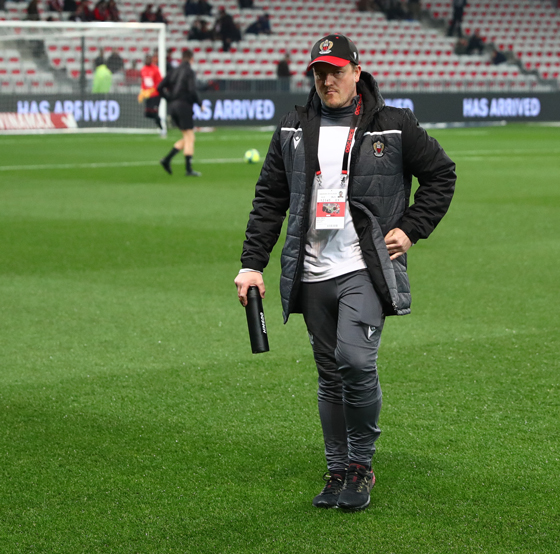
What about Allianz Riviera?
Consistency is key in the pitches that you train on and the pitches that you play on. They should be very, very similar. That's the whole point of home advantage. If you train on the pitch all week and you go and play on the same pitch at Allianz Riviera, then you'll adapt very quickly and your performance level will be higher. If you trained here on a very good pitch and then went to a stadium and the pitch wasn't at the level of the training pitch, then it takes you 10, 15 minutes to adapt to it and the difference. And that could be the difference between winning a game and losing the game. So for me, it's critical that the two, the training ground and Allianz Riviera are as similar as possible. That’s what we’re working for.


